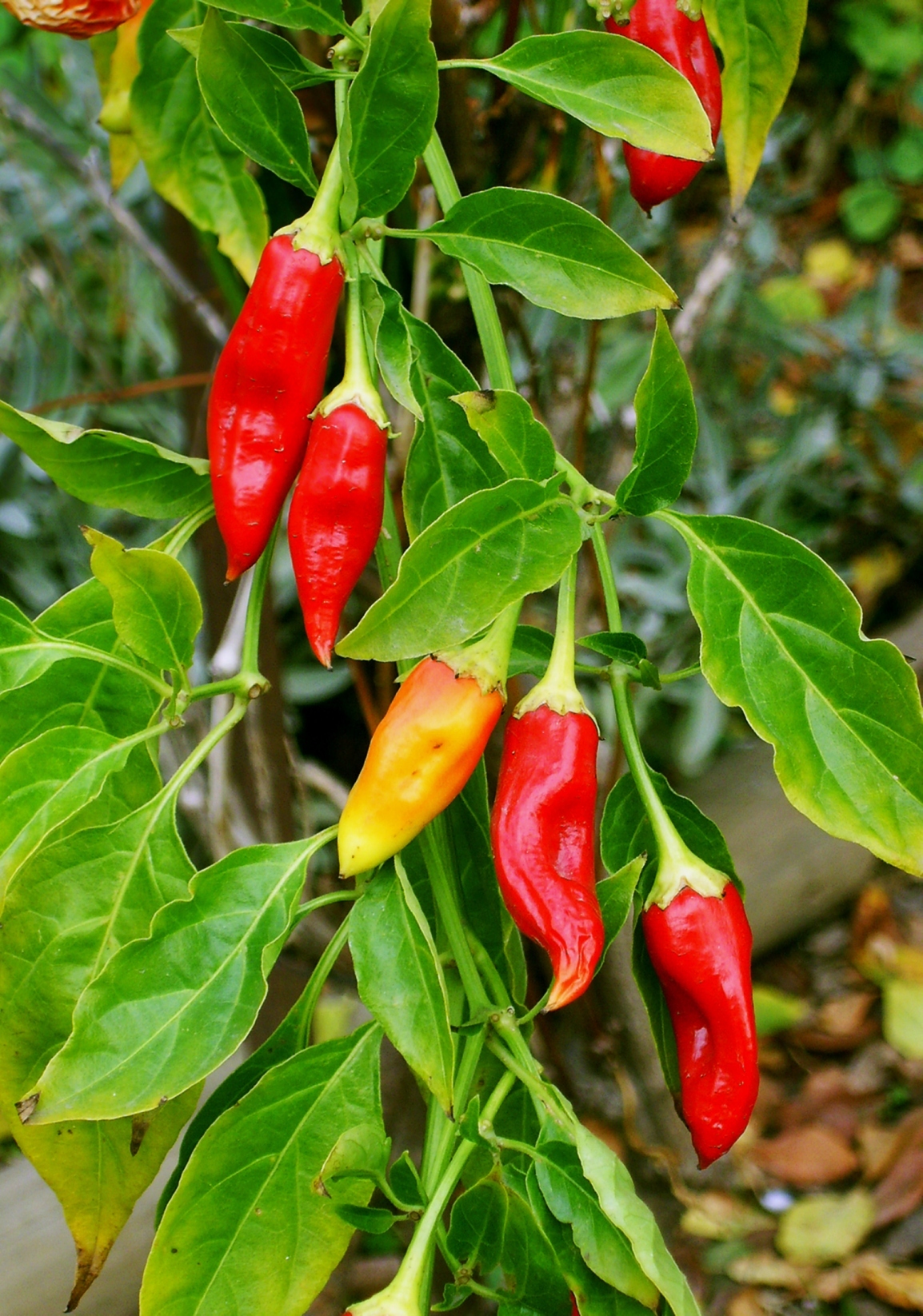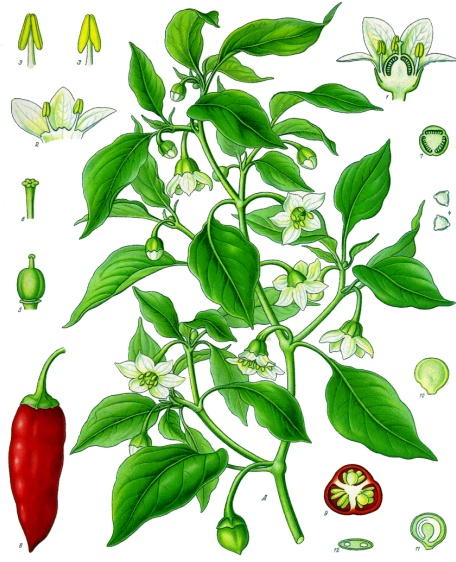Capsicum minimum (Roxb.) / C.fructescens (L.)
Synonyms: C.fastigiatum (Bl.), African chillies, chillies, red pepper, bird pepper, capsicum, hot pepper, Tabasco pepper
Order: Solanaceae
Description: This small erect shrub is indigenous to tropical America and cultivated in South America and Africa. It is a perennial plant in its native America but is annual when cultivated outside tropical zones. Growing to a height of 1m or more, its glabrous stem is woody at the bottom and branched near the top. The leaves are ovate to lanceolate, entire and petioled. The drooping, white to yellow flowers grow alone or in pairs or threes between April and September. The ripe fruit, or pepper, is a many-seeded pod with a leathery outside in various shades of red or yellow.
Part Used: dried ripe fruit
Collection: harvested when fully ripe and dried in the shade
Constituents: an alkaloid (capsaicin), carotenoids (capsanthine, capsorubin), flavonoids, volatile oil, vitamins A, B and C, steroidal saponins (capsicidons), sugars, fatty acids.
Actions: carminative, spasmolytic, stimulant, diaphoretic; externally as a rubefacient, counter-irritant and antiseptic.
Indications: flatulent dyspepsia in the absence of inflammation, colic, insufficiency of the peripheral circulation; as a gargle for chronic laryngitis; externally for neuralgia, rheumatic pain and unbroken chilblains.

Therapeutics and Pharmacology: Capsicum is a good general tonic, specific for the circulatory and digestive system. It regulates blood flow and strengthens the heart, arteries, capillaries and nerves. It improves arterial blood supply to the tissues and toxin removal. It is a strong circulatory stimulant, appearing to reinforce the action of certain prostaglandins, thereby increasing the flow of blood through all the tissues of the body and producing a diaphoretic effect. Capsaicin is known to mimic the effect of some of the prostaglandins. It desensitizes the sensory nerve endings to pain stimulation by depleting Substance P from the nervous system, which is the basis for its use as a local analgesic, and recent research suggests that cayenne can ease the severe pain of shingles and migraine. It is also used in digestive debility and flatulent dyspepsia in the absence of inflammation. The addition of Capsicum to a prescription will ensure that the other ingredients quickly reach all tissues even where there is poor circulation.
Applied externally it stimulates increased circulation within the subdermal tissues, reducing the need for the body to invoke the inflammatory response. It is therefore of benefit as a rubefacient for neuralgia and rheumatic pains. The ointment also helps to heal unbroken chilblains.
Caution: Should not be used in cases of hypertension, gastric hyperacidity, peptic ulceration, or on mucous membranes. The hands should be washed after handling. Prolonged application to the skin can cause dermatitis and blistering, while excessive consumption can lead to gastroenteritis and liver and kidney damage. Only small doses should be used to avoid irritating the stomach or burning the skin. The seeds can be toxic. Therapeutic doses should be avoided during pregnancy and while breastfeeding.
Combinations: Capsicum combines well with Commiphora as a gargle for laryngitis or as an antiseptic wash. It may be combined with Althaea and Filipendula for flatulence or spasm of the digestive tract.
Preparation and Dosage:
Regulatory Status: GSL.
Oleoresin, maximum dose 1.2mg. Maximum daily dose 1.8mg.
Infusion - pour a cup of boiling water onto half a teaspoon of cayenne and infuse for ten minutes. A tablespoon of this infusion should be mixed with hot water and drunk as required.
Tincture: 1:20 in 60% alcohol - 0.25-1ml three times a day or when needed.
Compress: soak a pad in the infusion and use for rheumatic pains, sprains and bruising.
Additional Comments: Cayenne or Capsicum derives its name from the Greek 'to bite' in allusion to the hot and pungent properties of the fruit and seeds. A native of Peru, it was introduced into Europe by the Spaniards in the sixteenth century. The Portuguese then took it to India, from where it was known as Ginnie pepper. Gerard mentions it as being cultivated in his time and describes it as 'extreme hot and dry, even in the fourth degree', recommending it for scrofula. It was a central remedy in the North American Physiomedical tradition, where its warming properties were used for chills, rheumatism and depression.
Bibliography
BHMA 1983 British Herbal Pharmacopoeia, BHMA, Bournemouth.
Grieve, M. 1931 A Modern Herbal, (ed. C.F. Leyel 1985), London.
Hoffmann, D. 1990 The New Holistic Herbal, Second Edition, Element, Shaftesbury.
Lust, J. 1990 The Herb Book, Bantam, London.
Mills, S.Y. 1993 The Essential Book of Herbal Medicine, Penguin, London (First published in 1991 as Out of the Earth, Arkana)
Mills, S.Y. 1993 The A-Z of Modern Herbalism, Diamond Books, London.
Ody, P. 1993 The Herb Society's Complete Medicinal Herbal, Dorling Kindersley, London.
Polunin, M. and Robbins, C. 1992 The Natural Pharmacy, Dorling Kindersley, London.
Wild, A. 1995 The East India Company Book of Spices, Harper Collins, London.
Wren, R.C. 1988 Potter's New Cyclopaedia of Botanical Drugs and Preparations, Revised edition, C.W.Daniel, Saffron Walden.










